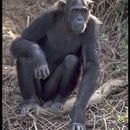Biology
(
الإنجليزية
)
المقدمة من Arkive
Chimpanzees are highly intelligent, social animals with a startlingly complex culture. They live in stable communities which range in size from 15 to 150 members, although individuals tend to travel and forage in much smaller groups (4). Males stay in their natal community for life and male relationships are ordered in a strict linear hierarchy, which allows many disputes to be settled without the need for violence (4); males are also dominant over all of the females in the group (5). Chimpanzees are long-lived and do not reach sexual maturity until they are around 10 to 11 years old, with inter-birth intervals of around five years (5). Young chimpanzees develop slowly and are weaned at around four years old (4), although they retain strong ties with their mother after this.
Chimps are active throughout the day and feed mainly on fruit, supplementing their diet with leaves, flowers, seeds and insects when fruit is scarce (4). Meat is a favourite food for chimps and groups will cooperate together to hunt and kill monkeys (5). Chimpanzees are remarkably dextrous and are one of the few species to exhibit tool use; from fly wisps and nutcrackers to rods used to probe for ants and termites (4). Chimps exhibit complex communication in the form of expressions, postures and calls (5); social grooming is vital for maintaining bonds between individuals (4).
Conservation
(
الإنجليزية
)
المقدمة من Arkive
Chimpanzees are protected by law throughout their range although this is often poorly enforced. The precise impact of the bushmeat trade is currently being investigated by the Bushmeat Working Group, part of the Convention on International Trade in Endangered Species (CITES) (9). The United Nations Environmental Program (UNEP) has recently recognised the urgent need to protect our closest relatives and has established a Great Ape Survival Project (GRASP) aimed at identifying the conservation initiatives required to secure the future of the apes and obtaining political support and funding to allow these to be achieved (10). The Jane Goodall Institute, amongst other organisations, is involving local people in chimp conservation in the form of sanctuaries and education programmes (5).
Description
(
الإنجليزية
)
المقدمة من Arkive
Along with the pygmy chimp or bonobo (Pan paniscus), the chimpanzee is the closest living relative (4) to humans and is estimated to share 98 percent of our genes (6). There are currently four recognised subspecies of chimpanzee, showing differences in appearance and geographic range: the western or masked chimpanzee (Pan troglodytes verus), central or black-faced chimpanzee (P. t. troglodytes), eastern or long-haired chimpanzee (P. t. schweinfurthii) and the eastern Nigeria chimpanzee (P. t. vellerosus) (3). They all have the characteristic chimpanzee body shape with longer arms than legs, together with opposable thumbs and big toes (5). The bare skin on the face, ears, palms, and soles of the feet is pinkish to black (5), whilst the rest of the body is covered with brown to black hairs (6). Chimpanzees have very expressive features with their bulging eyebrows and protrusive lips (6). The long arms and fingers and mobile shoulder joints allow chimps to move easily in the trees where they forage and rest (4). The majority of their locomotion however, takes place on the ground in the form of 'knuckle-walking' (4).
Habitat
(
الإنجليزية
)
المقدمة من Arkive
Inhabits a variety of woodlands from humid evergreen forests to deciduous forest and dry savanna woodlands (7).
Range
(
الإنجليزية
)
المقدمة من Arkive
Once found throughout the equatorial forest belt of Africa from the west to east coast of the continent (5), between 13°N and 7°S (2). Populations are today found where tracts of these forests remain and the largest populations are located in Gabon, Zaire and Cameroon (2).
Status
(
الإنجليزية
)
المقدمة من Arkive
Classified as Endangered (EN) on the IUCN Red List 2007 (1), and listed on Appendix I of CITES (3). Subspecies: western or masked chimpanzee (P. t. verus); central or black-faced chimpanzee (P. t. troglodytes); eastern or long-haired chimpanzee (P. t. schweinfurthii); eastern Nigeria chimpanzee (P. t. vellerosus) are all classified as Endangered (EN) on the IUCN Red List 2007 (1).
Threats
(
الإنجليزية
)
المقدمة من Arkive
Habitat loss from mining, forestry and agriculture is one of the major threats to wildlife in equatorial Africa at present (8). Deforestation in west Africa is most severe and remaining pockets of undisturbed forest are home to highly fragmented populations of chimpanzees (8). The demand for bushmeat has recently exploded due in part to the growing human population, more accessible forests and the increased availability of firearms (4); some conservationists believe this trade is currently the biggest threat to species' survival in the area. Exposure to human diseases presents a further threat to the chimpanzee (8).

